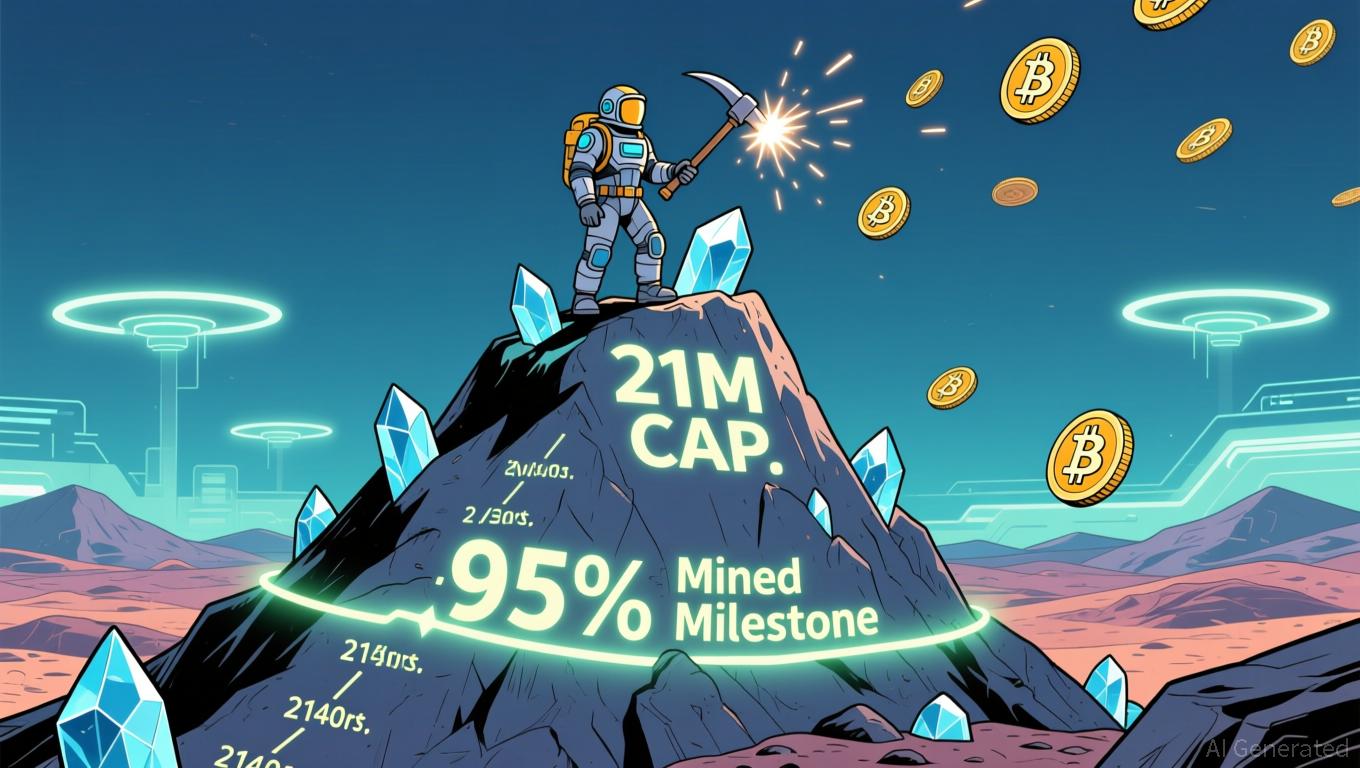Bitcoin News Today: 95% of Bitcoin's Supply Reached—A Powerful Symbol of Scarcity Triumphing Over Fiat Currency Devaluation
- Bitcoin's supply now exceeds 95% of its 21 million cap, with 2.05 million remaining to be mined by 2140 via halving mechanisms. - The 2024 halving reduced block rewards to 3.125 BTC, intensifying miner reliance on fees as output halves every four years. - Experts highlight Bitcoin's scarcity as a hedge against fiat debasement, though price impacts remain limited as adoption and regulation gain priority. - New projects like Bitcoin Munari aim to replicate Bitcoin's capped supply model while adding program
More than 95% of Bitcoin's total 21 million supply has now been mined, representing a significant achievement in the cryptocurrency's 17-year journey.
The remaining coins will be gradually released over the next hundred years, with the last Bitcoin expected to be mined around 2140. This timeline is governed by the halving process, which cuts the block reward every four years.
Analysts point out that reaching 95% is more symbolic than a direct driver of price changes. "This is a narrative milestone that reinforces Bitcoin's scarcity principle, but it won't cause an immediate price shift,"
The shrinking supply has put greater strain on miners, who are increasingly dependent on transaction fees as block rewards diminish.

Institutional interest continues to play a vital role in Bitcoin's long-term prospects.
At the same time, new ventures are adopting Bitcoin's scarcity model.
As the last 5% of Bitcoin's supply gradually enters the market, attention turns to how the network will maintain security and foster adoption. With miners adjusting to a fee-based revenue model and institutions deepening their involvement, the 95% mark stands as a testament to Bitcoin's robust design: a digital asset engineered to withstand devaluation, block by block.
Disclaimer: The content of this article solely reflects the author's opinion and does not represent the platform in any capacity. This article is not intended to serve as a reference for making investment decisions.
You may also like
Astar (ASTR) Value Soars: Protocol Enhancements and Practical Use Cases Drive Cryptocurrency Growth
- Astar (ASTR) surged 1.95% as protocol upgrades and real-world adoption drive institutional confidence and whale accumulation. - Tokenomics 3.0 shifts to a fixed 10.5B supply by 2026, aligning incentives with deflationary mechanisms and cross-chain interoperability. - Partnerships with Casio, Sony , and Animoca expand ASTR’s utility in loyalty programs and Web3 ecosystems, boosting on-chain activity. - Despite a 24-hour volume of $5.6M, challenges like DeFi TVL declines and liquidity risks remain critical
Aster DEX Experiences Rapid Growth in DeFi Usage: Is This the Dawn of a New Era for Decentralized Finance?
- Aster DEX's hybrid AMM-CEX model and AI-driven liquidity routing drove 2M+ users in Q3 2025, addressing DeFi's slippage challenges. - Transparent tokenomics with public unlock schedules and 5% fee discounts stabilized ASTER's price, reaching $1.13 with $2.27B market cap. - Strategic Binance partnership enabled $3T+ trading volume, while Pro Mode and perpetual contracts expanded token utility beyond governance. - Despite centralization concerns and volatility-related glitches, Aster's crisis response and
Brazil's cryptocurrency rules drive capital inflows as other markets see outflows
- Brazil introduces tax on cross-border crypto transactions, aligning with CARF and OECD standards to close regulatory gaps and boost revenue. - Global crypto funds face $3.2B in outflows, driven by macroeconomic uncertainty and whale selling, contrasting Brazil's $42.8B crypto surge in H1 2025. - Brazil's $1.7T on-chain activity and stricter AML rules position it as a regional crypto oversight benchmark, expanding government visibility into crypto flows. - While U.S. crypto ETFs see $1.97B outflows, Germa

Fed Faces December Decision: Easing Labor Market Pressures or Tightening Inflation
- The Fed faces a December rate cut decision amid internal divisions, with a 50% chance of easing as labor market weakness clashes with inflation risks. - Governor Waller advocates for a 25-basis-point cut to support the slowing jobs market, contrasting with cautious officials like Collins and Jefferson. - Liquidity imbalances push the effective funds rate near the 3.90% excess reserves rate, prompting Treasury bill purchases to stabilize reserves and rates. - Market expectations remain calm, pricing in gr
